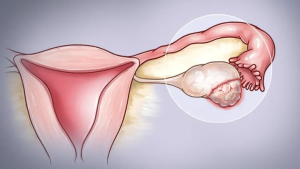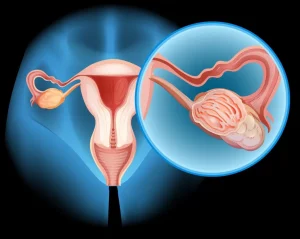Breast and ovarian cancers are two of the most common and deadly malignancies that women get around the world. Even though the breasts and ovaries are in different parts of the body, scientific research has proven that they are biologically linked over the years. Genetics is a big part of this relationship, especially when the BRCA1 and BRCA2 genes change. It’s important to understanding how these mutations affect the growth of cancer and to uncover common risk factors and ways to stop it from growing so that cancer can be diagnosed early and treated successfully.
BRCA1 and BRCA2 are two genes that keep cancers from getting bigger. They normally fix damaged DNA, which keeps the genetic material of a cell stable. But when these genes are modified, they can’t do their job of protecting cells, which could make them grow too quickly and possibly turn into cancer. Women who have a deleterious change in either BRCA1 or BRCA2 are far more likely to get breast or ovarian cancer. Not just moms can make these changes; either parent can. Because of this, both men and women can have these mutations and pass them on, even if they never get cancer. This argument makes it clear how important it is to know the medical history of both sides of the family.
The American Cancer Society and many other studies suggest that women with a BRCA1 mutation had a 72% likelihood of getting breast cancer and a 44% chance of getting ovarian cancer in their lifetime. Women with a BRCA2 mutation are less likely to have breast cancer (up to 69%) and ovarian cancer (up to 17%), but the risks are still high. The chance of getting ovarian cancer in your lifetime is about 1.3%, while the chance of getting breast cancer is about 13%. Compared to the average person, these data suggest a big increase.

These tumors have a beneficial influence on each other. A woman is more likely to get ovarian cancer if she has breast cancer, especially if she was diagnosed with it early in life or if her family has a long history of the disease. Research shows that persons who had breast cancer were roughly twice as likely to have ovarian cancer as people who didn’t have breast cancer. People with BRCA mutations are more likely to have this association, although people without detectable mutations may also be at higher risk because of common hormonal, environmental, or lifestyle factors.
Your family history is still one of the best ways to figure out if you’re prone to get sick. If a woman’s mother, sister, or daughter has had breast or ovarian cancer, she is far more likely to acquire it herself. This is especially true if a lot of female relatives were diagnosed with one or both types of cancer while they were younger. Families can save lives by getting genetic counseling and BRCA testing. A positive test doesn’t mean a woman will get cancer, but it could give doctors vital information that helps them keep a closer eye on her and do things to keep her from getting it.
If you know how probable it is to happen in your family, you have more options for avoiding it before it begins or finding out about it early. More screenings is one way to do this. Women who are at high risk for breast cancer may start obtaining screenings sooner than average women. They often combine mammograms and breast MRIs to get more accurate results. It’s still hard to find ovarian cancer early, but certain women who are at high risk may get blood tests and transvaginal ultrasounds on a regular basis to look for signs of the disease.

People who are at high risk may choose to get surgery to lessen their risk in more serious situations. A preventative mastectomy, which is the removal of one or both breasts, can lower the risk of breast cancer by up to 95% for people with the BRCA mutation. A prophylactic oophorectomy, which is the surgical removal of the ovaries and fallopian tubes, could lower the risk of ovarian cancer by as much as 90%. Before menopause, reducing hormone levels may also greatly lessen the risk of having breast cancer. These are significant surgeries that have an effect on both the mind and the body, but a lot of women think it’s worth the difficulty because it could greatly lessen their risk of getting cancer.
There are other drug-related options. Selective estrogen receptor modulators (SERMs), like tamoxifen and raloxifene, can lower the risk of breast cancer in women who are at high risk by stopping the effects of estrogen. Some breast cancers can grow because of estrogen. These medications offer a less invasive way to lower risk than surgery, but they have side effects and aren’t right for everyone.
There are other things besides genetics that can make you more likely to get breast or ovarian cancer. Other things, including how you live and how you have kids, are also important. Both of these things are far more likely to happen as you become older. Obesity is another common risk factor since having too much body fat can elevate estrogen levels, which can subsequently feed cancers that are sensitive to hormones. Women who have never been pregnant or who have never carried a pregnancy to term may also be more at risk. This could be because their ovulatory cycles are still going on, which means they have more hormones in their bodies. Hormone replacement treatment (HRT), especially estrogen-progestin therapy, has also been linked to a greater risk of both types of cancer when used for a long time after menopause.
It’s scary to think that your genes might make you more likely to get cancer, but the good news is that knowledge is power. Women may now be able to take better care of their health than ever before since they know more, can obtain genetic testing faster, and can get medical care that is designed particularly for them. Women who are more likely to get sick should work with their doctors to make plans that will help them stay well. Some of these programs may need you to change your lifestyle, take medicine, get tested more often and earlier, or even have surgery to stop the problem.
In conclusion, there is a strong and clear link between ovarian and breast cancer, even though they happen in different areas of the body. This is especially important because the BRCA1 and BRCA2 genes have changed. Women can use this information to figure out how likely they are to have cancer, make smart decisions, and do things to avoid getting it or find it when it’s simplest to treat. To fight these deadly diseases, it’s important to find them early, look at your family’s health history, and have access to the newest screening and treatment options.
